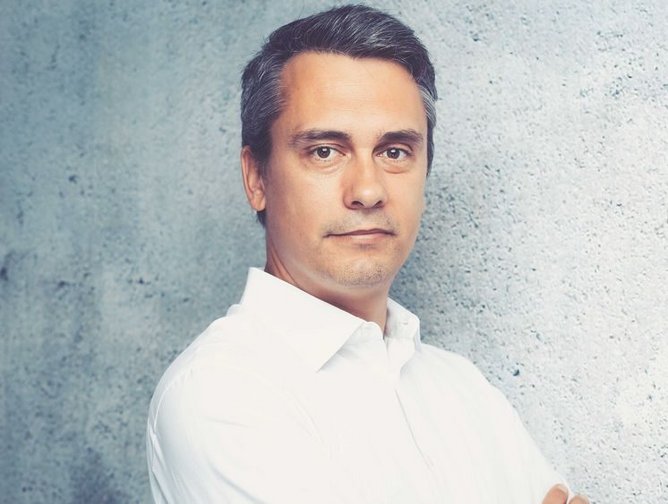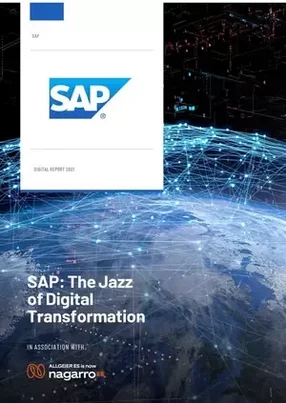SAP’s regional customer success team - Lars Friedrich, Andreas Spahn and Maria Fay - takes care of innovations in strategic customer engagements for middle and eastern Europe.
Friedrich has a musical analogy for what the team set out to achieve: “We act as innovation brokers, and we look upon the incubation and innovation team as a Jazz combo. We help customers to become digital sprinters and build sound innovation capabilities with the power of SAP’s innovation ecosystem
“From a Jazz point of view, it’s about bringing the tracks together to build up a full song at the end. That’s what we encourage our customers to do - finding the right beat to adopt innovation phase by phase and step by step.” That musical metaphor also underlies the philosophy that they believe companies must adopt to achieve digital transformation. “It’s not just about KPIs, but rather the whole symphony. You can't simply use technology to make every process perfect, but you can make sure that everything that you do inside of the process makes sense. And then, once the process has been properly structured and the people are enabled, the technology can come in.”
The Business Innovation Framework for SAP S/4HANA is the structure under which such transformation occurs. Increasingly, companies are digitally transforming their core businesses, but achieving that is highly complex. “Many customers have built highly customised applications over the years. It's a very complicated landscape that they have, and then, on top of that, they are considering: ‘how can I get from my old enterprise resource planning (ERP) software to a new ERP like S/4HANA?’ Then there’s the question of all the new technologies like machine learning or robotic process automation that everyone is talking about and figuring out what that means to the company.”
To cut through that fog, SAP has developed a systematic and structured approach to help customers identify which digital technologies in SAP’s vast portfolio could add additional value to their core businesses. “We have a lot of different tools and methodologies from design thinking to SAP Activate, which is our very own SAP methodology for business transformation in terms of ERP. We also have a huge portfolio of intelligent technologies, and that is important because when we talk to customers, they really want to know what robotic process automation, or machine learning, or even blockchain means to their business.” The innovation ecosystem encompasses a broad range of partners, including its venture arm SAP.iO for new product incubation. “We have many different experts across industries and business units that are all there to support the innovation journey of a customer. The whole ecosystem is very unique in the market, and really differentiates us from other competitors.”
SAP is not content to simply bring customers up to the modern digital standard, but goes further to identify technologies coming down the track. “What we do is help the customer to identify which technologies can add additional value on top of the standard offering, and technologies that are on the horizon. The next generation of business software that our colleagues from New Ventures and Technologies are exploring right now includes brain computer interaction, gaze control of software or homomorphic encryption and further emerging technologies.”
While that lies in the future, Fay points to a number of concrete examples regarding how technology can help improve business processes. “In the supply chain area it’s possible, based on historical data and machine learning, to predict how long it takes to process and ship the sales order. That, of course, allows customers to better plan their processes and in general improves customer relationships in the supply chain.” Other examples in the supply chain space include IoT sensors to monitor products in certain conditions. “You can track temperature, humidity, vibration, impact and so on. That is critical in industries like pharmaceuticals or consumer products where it's better to learn as soon as possible if there is any damage.”
Such examples cleave closely to SAP’s ambition with its customers’ digital transformations, as Spahn explains: “It makes sense to streamline your core processes, but, at the same time, you must identify where advanced technologies could add additional value to your business processes. Where do you need to skill up your people or future proof your workforce in order to not lose ground on your competitors in the race? It’s important to address the two worlds at once.”
One of the elements that sets SAP apart from the crowd is its partner ecosystem, which informs and interacts with the business innovation framework. SAP and its partners, together with customers, accelerate innovation adoption, providing the governance, methodologies and technologies for the situation at hand. “SAP is an ecosystem-oriented cooperative with over 21,000 industry, technology, start-up partners and research institutes. We believe that the collaboration with partners is key for our customers,” says Friedrich. “We integrate and take advantage of a performing ecosystem to solve customers’ digitalization shift. We onboard partners into niche areas to gain trust and once we have identified a backlog of use cases we hand-over delivery to certificated providers.”
Apart from the partner ecosystem, “SAP also has a strong internal ecosystem of various teams coming together in the jazz orchestra – from technology foresight to startup scouting,” as Fay explains. “SAP’s Innovation Center Network is working with visionary startups leveraging SAP’s business cloud platform, one data model and technologies to build products and support customers on their transformations. Another team has expertise in the context of sustainability and developed an Impact Lab for Sustainability – a format to apply horizon-thinking of environmental, human, economic and social factors into customer organisation, and identify sweet spots for new business opportunities and co-innovation. More and more we are opening up internal formats for our customers, like the SAP One Billion Lives program, which empowers social entrepreneurship with SAP products, services and networks. All those elements are crucial to ensure customers are leveraging the latest knowledge and achievements. “
The ongoing COVID-19 pandemic has naturally affected SAP, just as it has its customers. Consequently, SAP is offering solutions and services to help out. “One of many examples is called the business operation self-healing service,” says Fay. “It’s a comprehensive out-of-the-box AI platform to support automation in the business operations. In other words, if allows fast deployment of various use cases from restoring unplanned outages to interactive sales order issues resolution.” Spahn points out that while the natural instinct in such challenging times is to cut innovation budgets and focus on what is necessary to survive, this can be self-defeating. “Reducing the innovation budget in the long term can have a major impact on competitive capabilities in the future. After all, it’s the digital maturity level of a company that is a good indicator of the level of resilience to coping with these situations.”
The team emphasises that the key benefits of the digital transformations SAP enables are not just monetary. Sustainability is of ever-increasing importance in the business world, and the efficiencies digital transformation unlocks go a long way to helping out. “Big companies like SAP quite clearly have a full sustainability strategy, but the question is how to reach out to the midsized and older companies,” says Friedrich. “They also need to look into what sustainability actually is and how they could set up their enterprise to achieve it. That’s why we’re setting up a framework for sustainability called ‘the sustainable enterprise’. That answers the questions of how a company can use digital technologies to operate in a more efficient, and more sustainable manner.”
Nagarro ES
“Nagarro ES is an SAP full service provider, meaning we implement, and consult our customers on SAP software. We're also part of a global company which focuses on technology not only with regards to SAP, but beyond,” says Julia Rettig, Director Marketing at Nagarro ES. The company’s expertise when it comes to SAP products is one of its USPs, as Rettig explains. “As a company in Germany, we have local SAP experts within a global organisation, and our mission is to drive the intelligent enterprise. That involves a focus on SAP and enterprise resource planning to build an enterprise architecture that works for the company involved.”
The ongoing COVID-19 pandemic has accelerated efforts towards digitalisation, specifically cloud solutions, as Manuel Sedlak, Teamlead SAP Cloud Services, explains. “We’re seeing the companies we work with jump into digitalisation. Almost every customer we've worked with in the last year has thought about whether it’s now time to jump to S4/HANA, and whether that should be an on-premise or cloud solution.” Nagarro had first hand experience of the efficacy of S4/HANA cloud, and the flexibility it offers, having used it for the past four years. “We were one the first customers in the world to use S/4HANA cloud. That’s why we decided to bring this to market, and with this approach, we were able to find new customers with whom to discuss the cloud success story.”
Nagarro works closely with its customers and SAP as part of a triangular relationship to get the best out of its SAP implementations. Sedlak gives as an example its work with a customer. “We were asked to be the implementation partner, but having a relationship between ourselves, the customer and SAP is really important for the overall success of the project.” That triangular relationship is reinforced by quick responses should a problem arise. “We identified a problem with a sales order that couldn’t be deleted from within the system,” says Sedlak. ”We raised a ticket and I was in direct contact with the customer success manager on SAP’s side. Within half an hour, we were able to find a solution, so it took just 30 minutes from reporting that incident to having a resolution from SAP.”
The extent of the relationship between SAP and Nagarro has meant the two can exchange ideas. “As a partner, it's really great to have a tight connection with SAP,” says Sedlak. “We are currently discussing some products with SAP which are coming next year. We are talking about a new configuration platform, for instance, that is in development and will potentially go live from the beginning of 2021.”
Rettig sees Nagarro’s full service, independent approach as standing it in good stead for the future. “Customers want to participate in all the latest technologies, but they need to do the homework. That’s where we come in, because we not only have the cloud perspective, but also do on premises projects. For us as a partner, it's important to consult our customers with an open mind. We don't want to push them into a corner where they don't belong. That's why we’ll continue to take a holistic view with our customers.”



- Leaders are obstructing their own environmental progressSustainability
- How SAP is facilitating continuous business transformationDigital Strategy
- SAP results: Cloud revenue grew to €12.56 billion in 2022Corporate Finance
- Leadership and transformation matter most to SAP customersLeadership & Strategy

